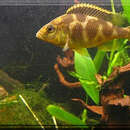Diagnostic Description
provided by Fishbase
Diagnosis: presence of a lozenged melanin pattern; no spots on pectoral fins; no radiating melanin pattern on the head; no highly contrasting, anastomosing horizontal and vertical melanin components on the body; body depth 38.1-40.9% of standard length; head length 32.0-33.8% of standard length; length of lower jaw 36.3-40.8% head length; dorsal fin base 53.3-57.7% of standard length (Ref. 55922).Description: relatively small mouth; outer teeth in jaw stout and bicuspid; inner teeth in jaw widely set and predominantly tri- and unicuspid, except in the largest specimens where they are stout and mainly unicuspid; 3 series of scales on cheek; lower pharyngeal jaw broad and shallow, with a relatively deep anterior blade; pharyngeal teeth widely set, sharp and stout, with some median teeth slightly enlarged; gill-rakers normal to short and stout; 22-24 scales in upper part of lateral line, 14-15 in lower part; 5-6 scales between pectoral and pelvic fins (Ref. 55922).Coloration: Live: melanin pattern as in preserved specimens (Ref. 55922). Adult territorial males: general color blue; dorsal and ventral parts of head darker; unpaired fins dark blue; pectoral fins grey; pelvic fins black; dorsal fin with broad white margin; distal part of caudal fin white/yellow; lower half of caudal fin typically with yellowish hue; pectoral fins with white leading edge; less territorial males are greenish, somewhat darker on dorsal and dorso-lateral parts, more yellowish on ventro-lateral and ventral parts, and head sometimes blue while body greenish (Ref. 55922). Females and immature males: background color silvery green with large yellow component on head and ventro-lateral and ventral parts of body; dorsal fin and upper part of caudal fin grey; dorsal fin with white margin; caudal fin typically with yellowish lower half; maculae and striae pattern on dorsal and caudal fins not well developed; pelvic and anal fins with yellow hue; pectoral fins transparent (Ref. 55922). Preserved: melanin pattern consist of large lozenge-shaped blotches on the flanks, with a network of anastomosing light colored zones in between: there are 4 dorsal blotches, 4 large blotches in the middle series, and 3 less obvious blotches on the ventral part; basic body color yellow to brown; head and branchiostegal membranes dark; lachrymal band sometimes present; fins brown with light colored parts, such as the dorsal fin margin, the distal margin of the caudal fin, the trailing edge of the pelvic fins and the ventral margin of the anal fin (Ref. 55922).
Diseases and Parasites
provided by Fishbase
White spot Disease. Parasitic infestations (protozoa, worms, etc.)
Diseases and Parasites
provided by Fishbase
Hole-in-the-Head Disease. Parasitic infestations (protozoa, worms, etc.)
Diseases and Parasites
provided by Fishbase
Bacterial Infections (general). Bacterial diseases
Life Cycle
provided by Fishbase
Female takes brood into her mouth and takes care of the young.
Morphology
provided by Fishbase
Dorsal spines (total): 16 - 17; Dorsal soft rays (total): 10 - 12; Analspines: 3; Analsoft rays: 9 - 10
Biology
provided by Fishbase
Found over sandy substrates (Ref. 5595, 55922). Juveniles may be found in shallow water near rocks while adults forage in deeper regions with sandy substrate (Ref. 5595). Feeds on small fish (Ref. 5595, 55922) and invertebrates (Ref. 55922). Half-grown individuals have been observed to remain motionless, partially buried in the sand, waiting for small fishes to come within reach (Ref. 55922).
- Recorder
- Crispina B. Binohlan
Nimbochromis venustus: Brief Summary
provided by wikipedia EN
Nimbochromis venustus, commonly called venustus hap or giraffe hap, is a Haplochromine cichlid endemid to Lake Malawi in Africa. It prefers the deeper regions of the lake (6 to 23 metres (20 to 75 ft)) where it hunts smaller juvenile cichlids with a specialised hunting technique. After spotting prey, it will partially submerge itself into the sand and lie motionless until the chosen fish comes within reach. it will then dart out of the sand and strike. It is related to Nimbochromis livingstonii. In the wild it is known to grow to 25 centimetres (9.8 in) TL though usually not exceeding a length of 22.5 centimetres (8.9 in) TL.
It is a popular freshwater aquarium fish. The fish are generally yellow with a pattern of darker, melanic blotches. Males will have a blue head and other blue colouring when they reach sexual maturity.
- license
- cc-by-sa-3.0
- copyright
- Wikipedia authors and editors

